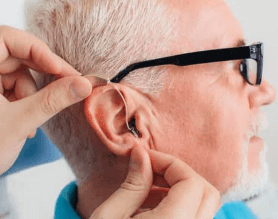Hi there and welcome to this post, where I am going to show you how to understand hearing test results.
All of your results are charted on what is called an audiogram.
An audiogram is a graph that shows your hearing abilities. It’s like a report card for your ears. When you take a hearing test, the results get plotted on this chart. This helps audiologists (hearing doctors) understand how well you’re hearing sounds. It’s a visual way of seeing how well you pick up different sounds at various pitches and volumes.
The purpose of this test is to find out if you have hearing loss, how severe it is, and what type you have. This is super important because untreated hearing loss can mess with your daily life – think about missing out on conversations with friends or not hearing your favorite music. The sooner you know, the sooner you can find ways to improve your hearing.
Understanding your audiogram results is crucial.
It helps you know what’s going on with your hearing. This info can guide you and your doctor in choosing the best treatments or hearing aids if needed. Plus, it’s pretty cool to understand how your ears work and what you can do to protect them!
How to Read an Audiogram Chart
An audiogram chart might look confusing at first, but it’s pretty straightforward once you know what everything means. The chart has two main parts: frequency (or pitch) and loudness (or volume).

Frequency is measured in hertz (Hz) and tells you how high or low a sound is. On the chart, it’s on the horizontal axis, starting with low pitches on the left and moving to higher pitches on the right. Think of it like piano keys – low bass notes to high treble notes.
Loudness is measured in decibels (dB) and shows how intense or loud a sound is. This is on the vertical axis, with softer sounds at the top and louder sounds at the bottom. Kind of like a volume knob on a speaker going from quiet to loud as you move down the chart.
When you take the test, the results for each ear are plotted as points on the chart. These points create a line that shows how well you hear different frequencies at various volumes. Kind of like a connect-the-dots drawing for your hearing ability.
One key detail on the chart is the symbols used. Usually, ‘O’ represents the right ear, and ‘X’ is for the left ear. Sometimes, other symbols or lines show how well you hear when using different methods, like bone conduction versus air conduction.
Understanding these basics can help you get a clear picture of your hearing health. It takes the mystery out of the chart and turns it into a useful tool for knowing what’s happening with your ears. If something seems off or confusing, your audiologist is there to help explain everything.
Recommended Reading: What Are The Best Hearing Tests Around?
Types of Hearing Loss
Understanding the type of hearing loss you have is crucial. There are three main types: sensorineural, conductive, and mixed hearing loss.
Sensorineural hearing loss occurs when there’s damage to the inner ear or the auditory nerve. This type of hearing loss is permanent. It’s often caused by aging, exposure to loud noises, or certain medical conditions. In an audiogram, this kind of hearing loss shows up as similar results for air conduction and bone conduction tests.

Conductive hearing loss happens when there’s an issue in the outer or middle ear that prevents sound from reaching the inner ear. Causes can include ear infections, fluid in the ear, or a perforated eardrum. On an audiogram, you’ll see a gap between the air conduction results (worse) and the bone conduction results (better).
Mixed hearing loss is a combination of both sensorineural and conductive hearing loss. This means there’s damage in both the outer/middle ear and the inner ear or auditory nerve. The audiogram for mixed hearing loss will show characteristics of both, with gaps between air and bone conduction results, plus an overall lowered hearing threshold.
Knowing the type of hearing loss helps in choosing the right treatment options. Whether it’s hearing aids, medical treatment, or surgical options, understanding your audiogram results points you in the right direction.
Now you know what those lines and symbols mean on your chart, and how they relate to different types of hearing loss.
>>Ready To Buy Your Hearing Aid, Click Here To Learn More<<
Interpreting Your Hearing Test Results
Interpreting your audiogram results can seem like deciphering a secret code, but it’s not as tricky as it looks. First off, understanding the hearing ranges is key. Normal hearing usually falls between 0 to 20 decibels (dB). If you fall within this range, your hearing is considered normal.
Moving beyond that, mild hearing loss ranges from 21 to 40 dB. This might mean struggling to hear soft sounds or understanding whispers. Moderate hearing loss, which falls between 41 to 55 dB, can make understanding regular conversation difficult without raising voices.
Severe hearing loss ranges from 56 to 70 dB. At this level, you’ll probably only catch loud sounds or nearby conversations. Anything above 71 dB is considered a profound hearing loss, where hearing aids or other assistive devices often become essential to help understand and interact with your environment.
Say your results show ‘O’ at 25 dB for a particular frequency—this indicates mild hearing loss in your right ear at that pitch. If there’s an ‘X’ at 60 dB for another frequency, that suggests moderate to severe hearing loss in your left ear for that tone.
Understanding these details helps you know exactly where you stand with your hearing.
If your results show any level of hearing loss, taking action early can make a huge difference in your quality of life. Your audiologist can guide you on the best next steps, whether it’s hearing aids, therapy, or other treatments.
What to Do If You Have Hearing Loss
Discovering you have hearing loss can feel like a bump in the road, but there’s plenty you can do to manage it.
First off, treatments vary depending on the type and severity of your hearing loss. For mild cases, a simple ear cleaning or medication might do the trick. In more severe cases, hearing aids or even surgery could be options.
Hearing aids are small electronic devices that amplify sound and make listening easier. They come in various styles, like behind-the-ear (BTE) or in-the-ear (ITE) models. Your audiogram results will help your audiologist recommend the best type for you. It’s amazing how something so small can make such a big difference!

Don’t underestimate the importance of early intervention.
If you suspect even slight hearing loss, getting tested and addressing the issue early can prevent it from getting worse. Plus, adjusting to hearing aids or other treatments is easier the sooner you start.
I know that wearing a hearing aid comes with challenges. Trust me, I know all about it. I was initially hesitant to go down that route, but I had no choice.
I went for a Phonak one, and it was a ‘cross.’ This means that I wear it on both ears. Unfortunately, it was very powerful and I had to resort at times to wearing only on one ear.
But the bottom line. My hearing aid was a lifesaver. I could do my pharmacy job, and hear my family and friends, and even listen to music. It’s not as clear before I had the hearing loss, but it’s way better than not having any hearing at all.
So, I do encourage you to go forward and get your ears checked up.
Protecting your hearing is something you can do daily. Avoid loud noises, use ear protection at concerts or when mowing the lawn, and give your ears a rest in quiet settings. Simple habits can make a big difference in maintaining your hearing health.
If you do end up with a hearing aid or other device, take the time to get used to it. Follow your audiologist’s advice on wearing it regularly and caring for it properly. It might feel strange at first, but soon, it’ll be a natural part of your routine.
Frequently Asked Questions about Audiograms
Hearing tests can bring up a lot of questions. Here’s some clarity on common concerns to help you feel more prepared and informed:
One common myth is that hearing tests are painful or uncomfortable. They’re quite simple and painless. You’ll sit in a soundproof booth with earphones and respond to different sounds and words. Easy as that.
How often should you get your hearing tested?
If you’re over 50 or work in a noisy environment, a yearly check-up is a good idea. For others, every three to five years should be fine. Always go for a test if you notice any changes in your hearing.
Wondering what to expect during a hearing test?
You’ll likely start with a brief discussion about any hearing issues you’ve noticed. The test itself involves listening to a range of sounds and words. The audiologist will chart your responses to create your audiogram.
Some folks worry about what happens if their test shows hearing loss. Remember, understanding your hearing health is the first step to better hearing. Your audiologist will walk you through your results and discuss the best options for treatment or management.
Do you have a question about your hearing test that we didn’t cover?
Don’t hesitate to ask below.
This site is designed to help you understand everything as far as hearing health and tinnitus are concerned.
Looking forward to hearing from you.
Regards
Roopesh
